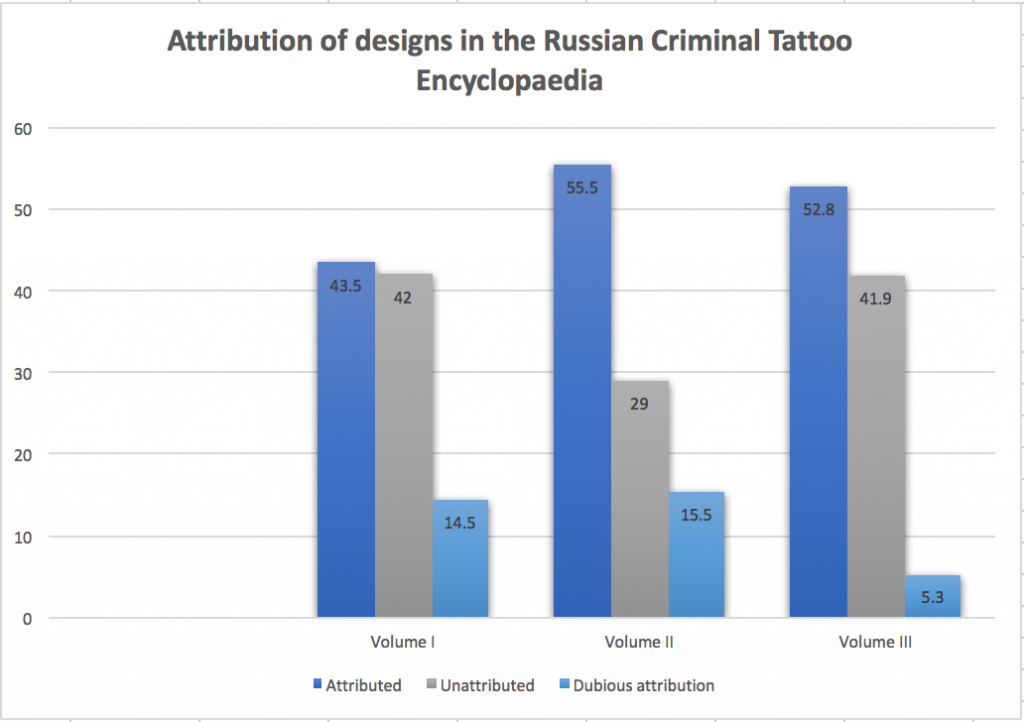
Tattooed former Soviet prisoner By pvz.lt [CC BY-SA 2.0 (http://creativecommons.org/licenses/by-sa/2.0)], via Wikimedia Commons
A fourth reason is the uncritical enthusiasm with which a lot of this material has been received. It’s hardly a surprise that fans of tattoos have shown such interest in the designs, but I have been somewhat taken aback by academic articles on criminal tattoos that treat them at face value, as though they are straightforward and unproblematic as sources. Helena Goscilo’s ‘Texting the Body: Soviet Criminal Tattoos’, in Cultural cabaret: Russian and American essays for Richard Stites, ed. by David M. Goldfrank and Pavel Lysakov (Washington, DC: New Academia Publishing, 2012), pp. 203–30 (available on academia.edu) is a prime example. I don’t question the analysis of the tattoos themselves, which is as fine as one would expect from a critic of Goscilo’s stature. But the fact that the author doesn’t think about what she’s analysing seems to me a rather unfortunate omission. Nevertheless, such articles, and the very ubiquity of this material, persuaded me that I ought to at least take a closer look to see whether these things are worth dealing with at any length in my book. In what follows I focus on the three volumes of the Russian Criminal Tattoo Encyclopaedia (London: Fuel, 2003-8), but also looked, for example, at a couple of volumes of Aleksandr Kuchinskii’s Prestupniki i prestupleniia: Zakony prestupnogo mira. Obichai, iazyk, tatuirovki (Donetsk: Stalker, 1997) and Lagernaia zhivopisʹ, ulgolovnyi zhargon (Donetsk: Stalker, 2008). Many of the same criticisms apply to a lot of these publications because most of them repeat substantially the same material.
And criticisms I have plenty. As we have to start somewhere, let’s kick off with Alexei Plutser-Sarno’s introductory essays in the first two volumes. The two are rather similar, except that the smattering of semiotics in the first volume (as befits a graduate of Tartu University) is replaced with a sprinkling of Baudrillard and Lacan in the second. What they both lack is any sort of historical contextualization (that does come in the third volume – of which more below), so it’s unclear what, or when, the author is actually referring to. Sources of information are equally unclear. A lot of the discussion of the meaning of tattoos is either not backed up at all, or uses Baldaev’s own explanations either from the Encyclopaedia itself, or from his Slovarʹ blatnogo vorovskogo zhargona, v dvukh tomakh (Moscow: Kampana, 1997), which is rather too self-referential to be reliable.
There’s also some really misleading use of other sources, notably of Mikhail Demin’s Blatnoi (Moscow: Panorama, 1991; translated as The Day is Born of Darkness) – which by coincidence I happened to have read a couple of weeks previously, and which I strongly recommend. In the first volume of the Encyclopaedia (p. 29), Plutser-Sarno cites Demin’s description in chapter 3 of part 1 of arriving at Kharkov Central Distribution Prison and being divided by the guards into criminals and others on the basis of their tattoos; Demin had an ace of clubs tattoo on his shoulder, so was assigned with the criminals. But far from illustrating the wider significance and particular meaning of tattoos, the whole point of Demin’s story is that he is in fact wrongly assigned, which we discover as his story unfolds. Although he ends up living with vory v zakone (thieves in the law or legitimate thieves), being a thief for a while, and in the camp later is on the thieves’ side in the Bitch Wars, this was all down to circumstances, namely finding himself alone as a teenager during the purges. (The Bitch War was a prolonged period of violence between two groups: the legitimate thieves, who refused any cooperation with the authorities, and the ‘Suki’ or ‘Bitches’, who did work for the authorities e.g. by serving the army during the war.) Demin was actually real Bolshevik aristocracy – from the Trifonov family (the novelist Yuri Trifonov was his cousin) – which was about as far away from the vory v zakone as you could get. The tattoo was not a sign of his status, but something he had done to remind himself never to gamble with cards again, after losing all his possessions, including the clothes he stood up in, to a thief playing with marked cards.
If Plutser-Sarno’s contributions don’t provide the sort of authoritative support one might hope for, Ann Applebaum’s Introduction to Volume II doesn’t do much better, because it’s very general and a lot of it doesn’t deal with tattoos at all. Where it does, it relies to a great extent on standard information, such as the well-worn story about criminals tattooing pictures of Lenin or Stalin on their chests as insurance against firing squads (not sure this would have helped them much in the purges, when a bullet in the back of the neck was the standard form of execution).
Alexander Sidorov’s Introduction to Volume III is a better proposition, as it has a far stronger historical basis and traces the development of tattoos in relation to Russian criminals. But the historical context he advances creates another problem. He identifies the Bitch War as the moment when the hidden meaning of tattoos took on real significance as thieves’ knowledge of who belonged to which group became a matter of life and death (pp. 33-5). Sidorov goes on to cite the emptying of the Gulag after Stalin’s death and Khrushchev’s Secret Speech as the moment when that hidden symbolism began to be lost, as tattooing moved into the mainstream with the reappearance within Soviet society of many criminals (p. 39). So if we’re generous and locate the beginning of the Bitch War at the start of the Great Patriotic War, rather than its end as if often suggested (certainly many of the memoirs I’ve read recently, including Demin’s Blatnoi and Dmitrii Panin’s otherwise fairly obnoxious Lubianka-Ekibastuz: lagernye zapiski (Moscow: Skify, 1991; translated as The Notebooks of Sologdin) indicate that a great deal of this violence was going on during the Great Patriotic War), and stick to 1956 rather than 1953 as the end point, that means these tattoos, with all their mysterious symbolism, were basically in circulation for around 15 years. Do they in that case really have the significance they are habitually endowed with today?
This sort of time-scale raises another issue when we look at the photos of criminal tattoos. Arkady Bronnikov began documenting tattoos in the mid-1960s, so is likely to have come across designs from this period, but it’s not clear which those are, as most of the information given is about the images but not their origins, dates etc. Sergei Vasiliev’s photos are dated 1989-1992, i.e. 30-odd years after tattoos ceased to have a meaning exclusively used and understood by criminals. It’s possible that one or two of his subjects are old enough to have gained tattoos before the time when their significance was diluted, but clearly most are not. So we really don’t know what we’re looking in these photos, whether the tattoos have meaning or are simply decorative.
Which, finally, brings me to one of the problems of Baldaev’s drawings themselves. Examining the drawings in all three volumes, alongside the photos by Vasiliev in the Encyclopaedia and elsewhere, as well as those by Bronnikov, reveals something a mismatch. Yes, many of the designs are the same, but many are not. Again, this raises questions about what is decorative and what has the specific meaning we have been led to believe. On the one hand, quite a few of the designs sported by the criminals in the photos look as though they may well be more decorative than meaningful (rather a lot of what look like perfectly standard portraits of women), especially in the case of Vasiliev’s images. On the other, at least we know these are indeed pictures of convicted criminals, as both photographers’ work comes from police and penal facilities.
The same cannot be said unreservedly of Baldaev’s drawings. The first thing I noticed is how vaguely many of them are attributed. I ended up doing a rough count, and came up with the following percentages:

I was fairly generous about what I counted as an attribution. Quite a few are attributed to people the author apparently met in bathhouses or on beaches. Make of that what you will. I can sort of imagine the conversations, but nevertheless gave these the benefit of the doubt as long as the bearer claimed to be a criminal or to have served a criminal sentence. Unattributed designs are those that simply indicate where on the body they are found, say there are multiple versions of a particular design, or just discuss the content but make no reference to the origin. Under ‘dubious attributions’ I counted ones that give no indication at all of criminal origins, including some taken from bodies in the morgue, tattoos belonging to German prisoners of war, sailors, nationalists etc. In other words, only just over 50% of all of Baldaev’s designs across the three volumes have any sort of reliable(-ish) indication of criminal origins. That doesn’t strike me as a great deal, and it certainly doesn’t strike me as being the sort of source a sensible academic should rely on. So I think that decides it: while I will have something to say in my book about tattooing practices as they are described in various memoirs, the criminal tattoo industry will probably merit a footnote at most.
